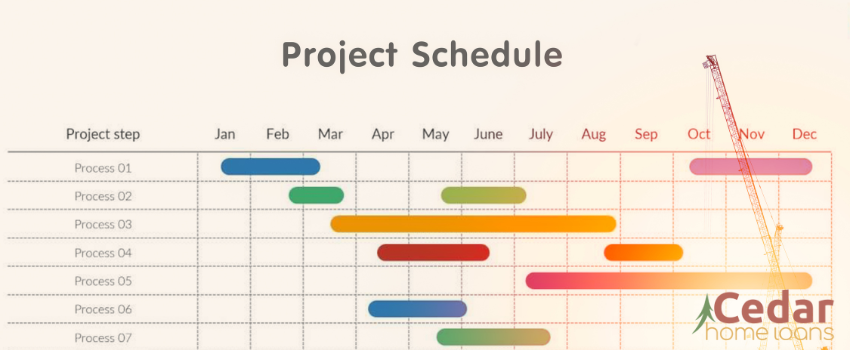In the intricate construction world, where many elements must align for a project to reach completion, the importance of planning cannot be overstated. Planning requires a detailed understanding of various factors, from resources and regulations to risks and relationships.
This article will embark on a journey that unravels the nuances of construction planning, explores the anatomy of a good construction timeline, and delves into the average timeline of different projects. Whether you are a veteran in the field or someone seeking to lay the first stone, this guide promises to be an essential compass in your construction endeavors. Let’s construct the future, one well-planned step at a time.
Definition of Construction Timeline
A construction timeline is a schedule of activities related to the planning, design, and execution of a building project. It includes developing plans, acquiring materials, obtaining permits, setting up sites, and performing any other work needed before starting construction.
Construction timelines are typically created using a template that outlines all of the necessary steps in chronological order. This helps ensure that all construction project components are accounted for and completed in the correct sequence.
5 Steps in Creating a Construction Project Timeline
Creating a project timeline for a construction project is an integral part of the process that requires the following steps:
1. Identifying Project Milestones
Identifying relevant project milestones is vital in creating an effective construction timeline. Knowing the critical tasks and their deadlines ensures that progress is monitored so potential delays can be addressed before they become costly.
When creating a comprehensive timeline, it’s essential to think through all the steps of the project—from beginning to end—breaking them down into more minor activities. Once these are identified, you can estimate how long each activity will take and set specific dates for each milestone.
2. Estimating Time for Each Phase
Accurately estimating the time required for each project phase is essential to creating a successful timeline. Once this has been established, it is necessary to consider all potential risks that may arise during the project’s duration, such as delays due to weather or unexpected complications.
These contingencies should be factored into the timeline when allocating time for each phase. It is also vital to research industry standards and compare them with internal experience to determine realistic deadlines that can be met within budget constraints.
3. Allocating Resources and Tasks
Properly allocating resources and tasks is integral to completing a project on time and within budget. The first step is determining the required resources for each job, such as materials, personnel, equipment, and tools.
Once the types of resources needed are identified, allocating them by their availability is essential. It may be necessary to prioritize tasks based on resource availability or cost-effectiveness.
Additionally, each task should have a designated individual or team responsible for its completion to maintain accountability throughout the process. Scheduling appropriately will help ensure deadlines are met and any delays or potential problems are promptly addressed.
4. Utilizing Project Management Tools
Utilizing the right project management tools can be vital to ensuring the successful completion of a project. Such tools help coordinate resources, manage tasks, track progress, and ensure quality control.
When it comes to construction timelines specifically, these tools can be handy for organizing complex tasks into a timeline that is both efficient and achievable. In addition, they have the potential to reduce risk by helping identify any potential bottlenecks or problems early on in the process.
5. Regular Monitoring and Adjustments
Regularly monitoring and adjusting the project plan can help achieve a successful outcome. This process entails consistently analyzing the progress of tasks against milestones to identify potential risks or opportunities and then responding accordingly.
The project manager should establish clear expectations for how often these reviews should occur and who will be involved in the process. It is also beneficial to develop contingency plans for any foreseeable scenarios that may arise, such as delays due to weather or unavailability of resources.
What makes a good construction schedule?
An effective and reliable construction schedule should possess the following factors:
1. Flexible and Realistic Timeline
Accurately assessing potential setbacks and adjusting the timeline is imperative for creating a realistic construction plan. A great way to increase your schedule’s success is to factor in flexibility for unforeseen events that may arise during the project.
For instance, unanticipated delays due to weather or material availability can affect deadlines and budgets. As such, it is essential to leave room for some leeway in the timeline to address these issues without causing further delays or cost overruns.
Additionally, all team members should be aware of any contingencies and have regular meetings to discuss progress updates and make necessary adjustments. This will help keep everyone on track and provide better control over the project’s duration and outcomes.
2. Transparent Task Delegation
Effective communication among all stakeholders is essential for completing a construction project. A clear and open dialogue between everyone involved in the project, including owners, contractors, architects, and subcontractors, is vital for ensuring that timelines are met and expectations are maintained.
When all parties understand their role in the project timeline, it allows them to understand the importance of their tasks and how they fit into the larger picture. This also helps to prevent any misunderstandings or conflicts leading to delays.
3. Risk Identification and Mitigation
Identifying and mitigating risks can be crucial for completing a construction project. Risk assessment is an integral part of the planning process, as it helps to identify potential problems that can arise during a project and provide solutions for them.
Construction projects involve many stakeholders with different interests, so it’s essential to consider how each stakeholder will be affected during delays due to unforeseen issues.
Since delays are unavoidable in some circumstances, including risk mitigation in your planning is crucial. This includes developing strategies to reduce or eliminate potential consequences of risks, such as delaying certain activities until later in the timeline or allocating more resources for particular tasks.
4. Project Goals and Objectives
Aligning the project activities with the goals and objectives of the construction project is essential for successful completion. The timeline’s structure should cover all stages supporting the project’s specific aim and intention to make it achievable.
All stakeholders must agree on how each activity contributes to meeting these objectives and how progress will be measured regularly. In addition, all changes need to be documented and communicated to all parties.
Responsibility for tasks must be assigned clearly so that everyone knows the roles they are expected to play throughout each stage. This approach allows all involved individuals to work together towards successful outcomes efficiently and effectively.
5. Regulations and Standards Adherence
Ensuring that all activities throughout the construction project adhere to relevant regulations and standards is critical to ensure safety, quality assurance, and proper resource management.
It is essential to review and integrate any local, state, or national standards during the planning process for the project timeline to remain on track. A construction timeline should include a section on compliance with applicable laws and regulations.
Developing a timeline should also consider potential obstacles or challenges while meeting these regulations.
Understanding the Average Timeline of a Construction Project
The average timeline of a construction project can vary depending on the size and scope of the project. Understanding the following stages is essential to creating an effective construction timeline that considers all necessary steps for completion.
1. Planning and Design
Successfully planning and designing a construction timeline template requires careful consideration of all relevant factors. This includes understanding the local laws, regulations, and zoning requirements; assessing socio-economic factors that may influence the project timeline; considering the materials required for construction; and consulting with engineers or architects to determine any special design features needed.
Furthermore, it is crucial to assess the availability of labor, equipment, building supplies, and other necessary resources for completing each construction phase. An effective timeline must also include budgeting for permits and fees associated with the project and setting aside funds for unexpected costs or delays.
2. Procurement
Procuring the necessary resources and materials for a construction project is crucial in creating an efficient timeline. It involves selecting vendors, obtaining estimates, and comparing options to identify the best value for money.
When negotiating with suppliers, considering quality, delivery times, cost, payment terms, and other relevant factors is essential. The selection process must also consider any legal requirements related to public procurement.
Additionally, it is vital to be aware of potential risks associated with this phase, such as unexpected delivery delays or changes in price due to market fluctuations.
3. Construction
After the procurement of materials and equipment is complete, construction can begin. An effective construction project timeline should include factors such as proper resource allocation, sequencing of activities, and scheduling.
Resource allocation involves allocating personnel, equipment, and materials to tasks to be completed on time. Meanwhile, sequencing of activities refers to prioritizing the order of tasks. Scheduling includes assigning specific start and end dates to each task and other necessary information like duration or constraints. Additionally, it’s important to establish checkpoints throughout the process to ensure progress goes smoothly according to plan.
4. Inspection and Closing
Once the construction process is complete, it must undergo inspection to assess if it meets all standards and regulations. Depending on the location, this may include a building inspector from the local government or a third-party contractor with expertise in safety and engineering.
The inspection should cover necessary permits, materials used, structural integrity, and other applicable regulations. Once the project has passed inspection, the next step is to complete the essential documents.
This typically includes paperwork such as certificates of occupancy and lien releases that must be filed with local authorities. All contractors must sign off on these documents before the payment distributions for services that are rendered.
The Bottomline
Planning and creating an effective construction timeline is paramount to the success of any construction project. From identifying clear milestones to estimating the time for each phase, the meticulous planning process ensures that resources are allocated wisely, risks are mitigated, and the project remains aligned with its goals.
Understanding what makes a good construction schedule and recognizing the factors that can influence the average timeline provides invaluable insights that enable professionals to navigate the complex and often unpredictable nature of the construction industry.
Keep your home construction on track with reliable financing from Cedar Home Loans.
Are you setting the blueprint for your ideal home? Ensure that every stage of your construction is financially secure. Our Dillon home loans are your steadfast ally in bridging funding gaps, allowing your project to flow uninterrupted. Contact us today and lay the groundwork for a worry-free home-building experience!






